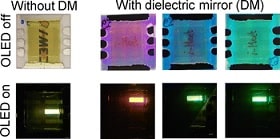C Bronnbauer, A Osvet, CJ Brabec, K Forberich – ACS Photonics, 2016
Semitransparent OLEDs are a candidate for large-area eco-friendly light sources that can be integrated into building facades, suggesting colorful windows that become luminescent if the OLED is switched on. However, since the light is emitted in two directions, smart light engineering has to be implemented to direct the light into a preferred direction and to prevent for instance huge energetic losses to the outside of a building. We introduce an unprecedented device architecture, composed of a dielectric mirror attached to a semitransparent OLED. Such a system features a dual functionality that depends on the viewing direction: changing the color perception and/or enhancing the light directionality while still preserving a high overall device transparency. First, we motivate the potential of this concept with a theoretical study, showing that broad modifications in the color range can be realized via device optimization and that the maximum possible emission enhancement of the OLED is limited only by the transparency of the interfacial layers and the electrodes. Then, experimental investigations with a semitransparent yellow OLED (transparency = 58.2%) in combination with six different dielectric mirrors validate the theoretical results. Retaining the same color perception, up to 80% of the total emitted light can be directed toward one side while the color is modified at the other side of the device stack. Here, modifications from yellow to purple to dark or light blue can be realized.

Page 1. 1 Semitransparent Organic Light Emitting Diodes with Bi- directionally controlled Emission Carina Bronnbauer1,2*, Andres Osvet1, Christoph J. Brabec1,2,3 and Karen Forberich1 1 Institute of Materials for Electronics …





